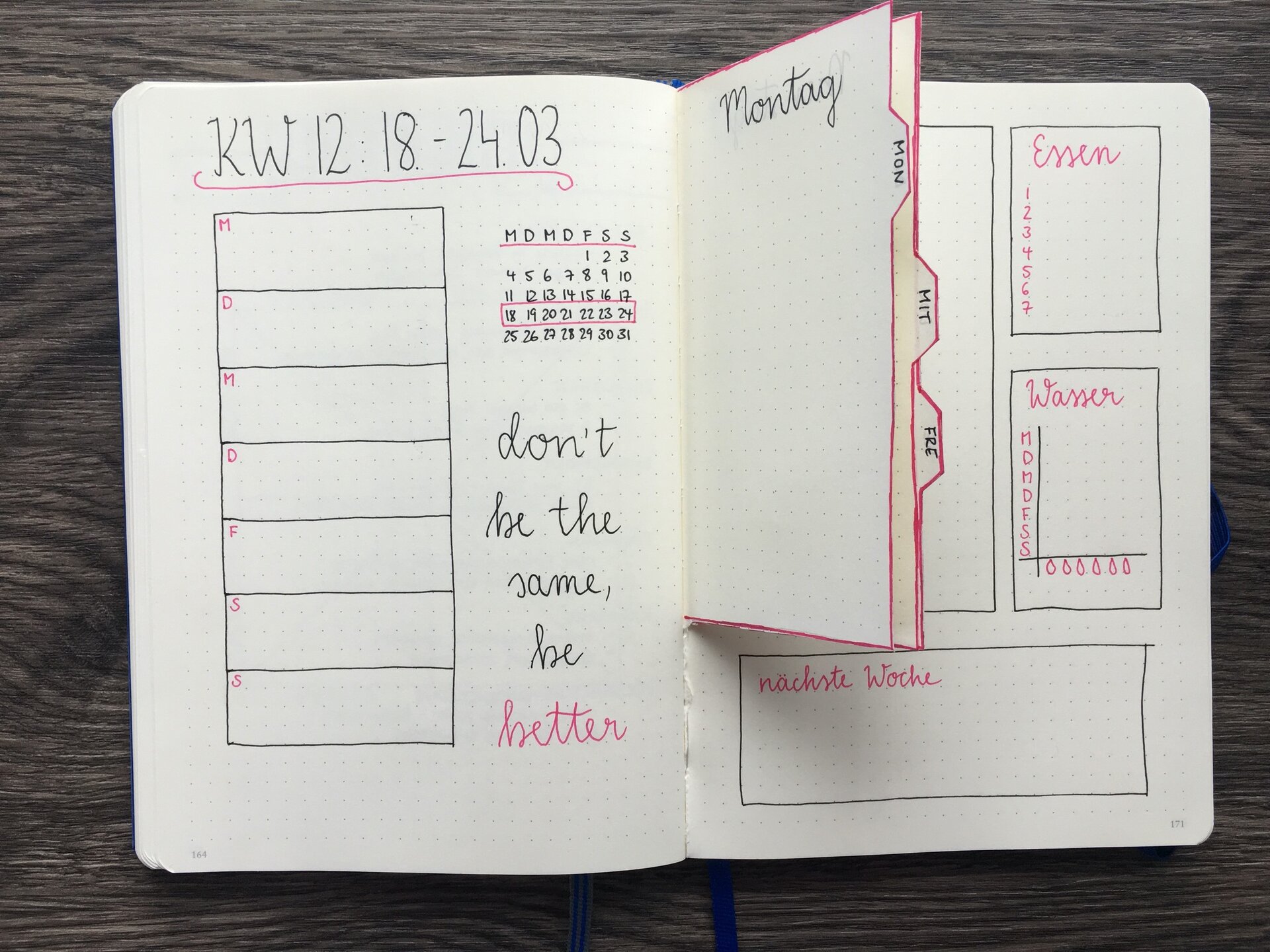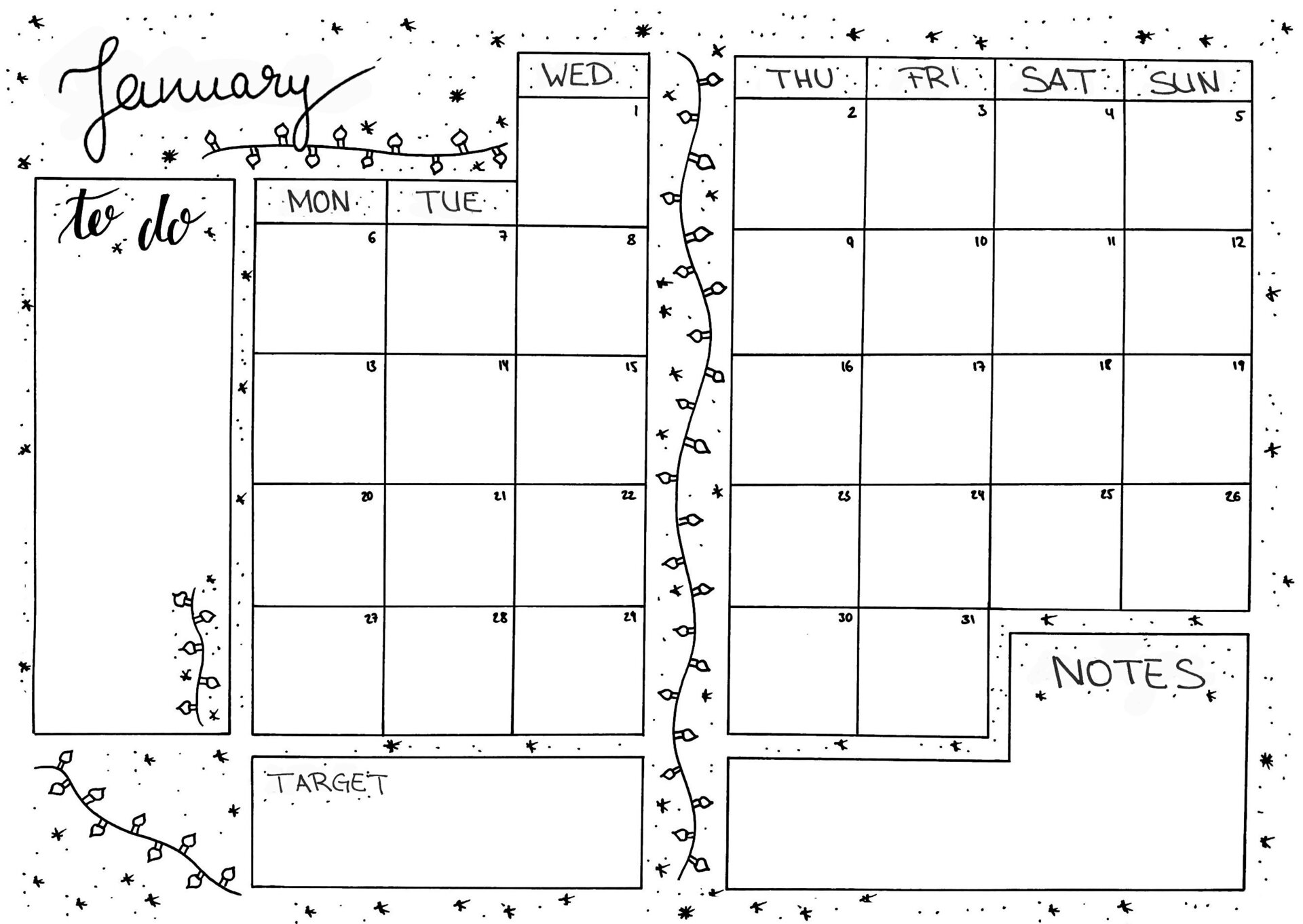So you’d like to start bullet journaling, but your everyday life doesn’t give you an hour each day to prepare the next pages? Does a bullet journal really require that much time? If you’re asking yourself this question, you’ve come to the right place.
The bullet journal duo Theresa & Lisa from punktkariert.de show you how easy it is to keep a bullet journal, provide you with important tips, and have even prepared a few templates for your Bullet Journal 2020 so that you can get started right away.
The 7 most important tips for finally starting a bullet journal – in just 5 minutes a day!
“Bullet journaling? I don’t know how to do that. And I wouldn’t have time for that anyway!” We constantly hear things like that from people whenever we tell them for the first time that we’ve been bullet journaling for years.
Of course, we also understand where they’re coming from. If you look on Instagram or Pinterest for inspiration for the next monthly overview or a mood tracker, the first impression you get is that it all looks so nice and second impression you get, above all is that must be a lot of effort!
But here’s the good news for you: It doesn’t have to be that way. You decide for yourself how much time you want to invest in it – there is no rule à la “at least 20 minutes a day, otherwise it’s not even worth it.”
Above all, the time factor definitely shouldn’t deter you from starting your bullet journal! We are giving you the 7 most important tips to finally get started now. The New Year is just around the corner after all – and it’s an excellent time for your first bullet journal!

Let’s start with the most important things right away: Before you delve into it, take a look at how bullet journaling actually works! Because even if the colorful and lavishly designed pages often might not suggest it, there is actually a system behind it. This system was designed by Ryder Carroll from the United States.
You’ll notice right away that the original system is very minimalistic! The design of the pages is definitely not the focus, rather it’s much more concerned with organization and mindfulness in your everyday life.
To learn more about the bullet journal system, you can either visit the website or (even better!) read Ryder Carroll’s book, “The Bullet Journal Method.”
According to Ryder Carroll, there are four modules or “collections” that make up the system: Index, future log, monthly overview, and daily overview. Additional lists, trackers, and overviews are inserted intermittently.
A lot of people start out by seeing a lot of pages they find beautiful and then transferring them to their bullet journal without knowing if they need them at all. Not only does it take up a lot of time to maintain these lists and trackers, but it also quickly leads to a lot of pages that were started but ultimately remained unused – and that can be demotivating.
Our tip: Start with the basics. Then you will quickly notice what additional lists, etc. you need and you can supplement your bullet journal accordingly. For a new list or overview, just open the next free page and fire away!
Admittedly, the first two tips don’t necessarily sound like just five minutes a day. It’s true! But the fact is: good preparation will definitely pay off in the end.
Ultimately, those who make a hasty start will take a lot longer than those who take the time at the beginning to prepare everything. Because it naturally takes a little time to understand the system at first and then also prepare the bullet journal – but in everyday life, it will look very different.
Incidentally, the idle days between Christmas and New Year’s are excellent for this preparation time!
Aside from the fact that it is always advisable to prepare for the following day the previous evening and “empty your head,” it will also save time the next morning.
Those who organize their to-do list in the bullet journal at work, for example, can quickly plan for the next day at the end of the work day – it shouldn’t take longer than a few minutes, since you’re ultimately still fully in the thick of it. The next morning you can simply go straight to work.
And if you use trackers, you can fill them out right in the evening!
Regular reflection is a major part of the bullet journal system! Thus: Do I really need all of the 7 trackers that I’m currently filling in (more or less) every day? Which of these really takes me further? Does the structure of my monthly overview work this way or am I missing something?
Regularly questioning and adapting your own system is extremely important and it’s simply part of it. Ultimately, your needs will inevitably change over time and what helped you along three months ago could potentially weigh you down today!
Therefore, regularly question what you actually need. Deleting redundant lists and trackers will also save you some time.
This is likewise a very important point in bullet journaling: Please do not put any pressure on yourself! There is no right or wrong. And that’s why it’s okay if some days remain empty for trackers – there is nobody checking up on anything.
The only thing that’s important is that you feel good with your bullet journal and that it takes you further! And if one tracker or another feels more like a burden (perhaps that sounds a bit dramatic, but it is thoroughly possible), check out Tip 5 again.
Your bullet journal is a great place to get creative – but it shouldn’t be a must or an obligation. Look at it as an opportunity: If you need half an hour to yourself, you can grab your bullet journal, and write, draw, do handlettering – whatever you feel like!
It’s perfectly fine for it to be a mix of something minimalistic and time-saving in everyday life as well as something that’s occasionally creative and colorful – your bullet journal will not judge you! Instead, it can serve as a great companion in your everyday life.
The great thing about bullet journaling is that anything at all is possible. You can decide every day what your pages will look like, how much time you want to invest in it, and how colorful it should be!
If you need help getting started, creative bullet journal templates are great. You can simply print them out, glue them in, and fill them out directly! There are three templates you can download for the perfect start to the New Year right here in the article.
Bullet Journal Templates for 2020
Start your bullet journal for 2020 now with the creative templates from Punktkariert.de. You can draw the templates or print them out and glue them in. It couldn’t be easier!
Templates for Mood Tracker can be found here.
punktkariert
- Lea & Theresa
Lea Giltjes and Theresa Taller discovered the Bullet Journal method in 2016 - since then the concept has never let go of them. Since the topic was not very widespread in Germany at that time, they launched Punktkariert, the first German blog about Bullet Journaling, at the beginning of 2017. On December 12, 2019 their first book "Dein geniales Bullet Journal Inspirationsbuch" appeared with 100 ideas for lists, trackers and goals in the Bullet Journal.
In addition to a lot of inspiration and tips, one thing is especially important for Punktkariert: A Bullet Journal can really be started by anyone!























